|
|
CRITICALLY ENDANGERED |
|
First discovered in 1938 in "dry forest habitat at Juruena, central Brazil," this bird was a mystery at the time of the publication of Threatened Birds of the World (2000) as it had not been seen in 62 years. In 2003, bird guide Bráulio Carlos rediscovered it along the Formosa River in Emas National Park, Goas, Brazil. In October 2004, Brazilian ornithologist Dante Buzzetti, following up on the report, heard a melodious song, and using playback, brought in a male Cone-billed Tanager. The following month, Buzzetti and Carlos filmed a pair of birds. Unlike published illustrations (all based on the single museum specimen), in life the bill of Cone-billed Tanager was strikingly pale, rather than black [from World Birdwatch, 2006]. Emas NP remains a consistent locale for Cone-billed Tanager. A fair number of pairs are present in seasonally flooded gallery forest along the Formosa River (habitat shown below). Marcelo found this male (left) by song every day we visited the boardwalk there. The species has since been discovered at Alto Rio Juruena, Mato Grosso, and several other sites. Given these facts and its expanded known range, it seems likely the bird will be moved to a less serious category in the future. For the moment, though, it was a fine experience to photograph this rare bird. Despite the name, there is serious doubt this bird is a tanager. A footnote to the SACC checklist notes that "Storer (1960) suspected that Conothraupis was closely related to Sporophila based on remarkable plumage similarities; Zimmer (1947) had previously suspected that Conothraupis was a "finch" and not a "tanager" based on bill shape." The pleasant warbling song is finch-like, and our guide believed it was not a tanager. It would not be surprising if genetic analysis (apparently not yet done) showed it belonged to the Cardinalidae or Emberizidae. |
|
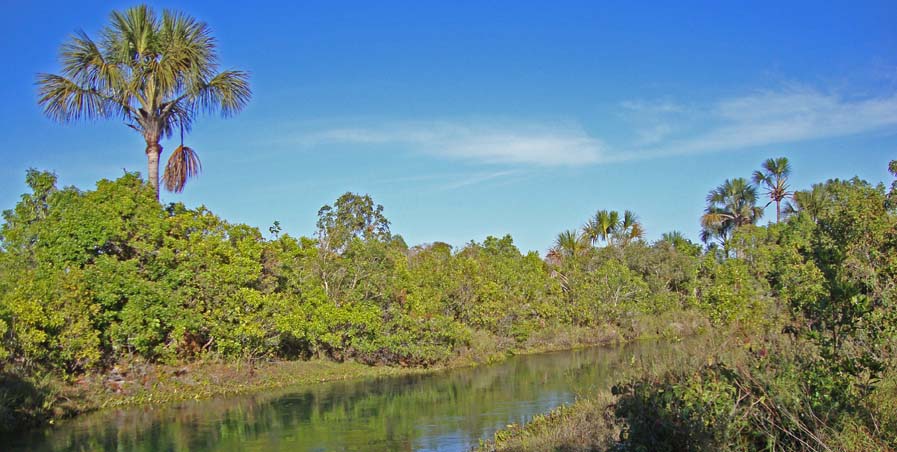 |
ENDANGERED |
This is the about the second largest eagle in the Neotropics (after Harpy; books vary as to whether Crested Eagle Morphnus guianensis is larger) and perhaps the world's 7th or 8th largest eagle. Although it has a wide range in the southern half of South America, we did not anticipate seeing it on this trip because of its rarity. Birdlife International says that it "qualifies as Endangered because it has a very small, fragmented population, and the severity of the threats it faces strongly suggest a significant and continuing decline in numbers. " We visited a remote valley in the eastern portion of Emas NP which had thick cerrado forest of much greater height than elsewhere in the park. We actually spotted three Crowned Eagles flying away from us early in the morning, but views were poor. Later, though, Marcelo spotted this perched subadult (above) that eventually took off and soared right over us (right). Marcelo took a lot of video of the eagle in flight and was more excited about this bird than anything else we encountered during our trip. It was interesting to see how much the pale head and blackish breast band recalled the huge Harpy Eagle in pattern. The obvious black thigh patches were not shown in any field guides we checked. |
The world's largest macaw is a spectacular component of the Pantanal avifauna. Birdlife International says that "species qualifies as Endangered because the population has undergone very rapid reductions in the past and the threat from illegal trapping for the cagebird trade plus habitat loss remains." Over 10,000 were taken from the wild in the 1980s. Today, though, it is seen as a tourist attraction in the Pantanal, where it feeds mostly on the hard fruit of a few regionally endemic palm species (Scheelea phalerata and Acrocomia aculeata). Some pousadas are planting these palms, but nesting cavities remain few. We did see Hyacinth Macaw daily in the Pantanal, including a nest along the Rio Cuiaba. |
| We also saw a male White-winged Nightjar Eleothreptus (Caprimulgus) candicans by spotlight at night as it flew over the road outside Emas NP. The male has extensively white wings and tail in flight, and is easily identified; a small dark nightjar also spotlighted that night could have been a female. Birdlife International says that "although the species may well be found to occur at other sites, it is currently known from just four locations, and it hence qualifies as Endangered." The four sites are Emas NP in Brazil, two in Paraguay, and one in Bolivia. Its habitat is dry cerrado. We saw the male flying from the park to forage over corn fields to the south. |
VULNERABLE |
According to Birdlife International, "rapid and extensive conversion of cerrado grasslands is presumably causing a rapid population reduction in this small tinamou. The population is now likely to be small and fragmented over a large range, and the species therefore qualifies as Vulnerable." We only saw one on our trip — this individual thinking of crossing the road late in the afternoon at Emas NP (left). It stayed at the road edge only briefly before running back into the grass. |
It was a surprise to find this on the list, and especially in the Vulnerable category, because this is a comparatively common roadside bird along the Transpantaneira through the Pantanal. Birdlife International says that "species is listed as Vulnerable because its small population and range are continuing to decrease owing to continuing habitat loss, with additional pressures from hunting." While it is "moderately common" in the vicinity of "Poconé, Mato Grosso ... the extraordinary paucity of historical and recent records suggests that elsewhere it is highly localized. Moreover, the concentration of recent records suggests that it may have been extirpated throughout much of its formerly large range." We did see fewer this trip than during our 1999 visit. Our best views in 2010 were of a family group feeding in flowering shrub along the Rio Claro (right). |
We had one good-weather day out the Carmelo Road in Intervales NP, and Edson found a pair of these gorgeous guans feeding on palm fruit in the forest (male, left). We had another small group the next day in drizzle. This species is rated Vulnerable "owing to the rapid and continuing reduction in numbers and habitat. Despite once being abundant, extensive habitat loss and heavy hunting pressure have extirpated the species from large parts of its former range and it is now very rare outside a few protected areas." |
"A total dependence on one or few species of bamboo whose reproduction is followed by massive die-off events, coupled with a substantial reduction in suitable habitat, suggests that this species's current population is small, fragmented and rapidly declining. It consequently qualifies as Vulnerable," states Birdlife International. We found pairs on two days at Intervales State Park, where they worked rather high in the canopy in mixed thickets of forest and bamboo. It was very difficult to get any photos; this is a male (right). It was very backlit and has been adjusted a lot in PhotoShop. |
Birdlife International says that the "combination of increased rates of habitat loss and more intense trapping pressures within this species's range in Paraguay and Brazil mean that its population is likely to have been undergoing rapid declines. For these reasons the species qualifies as Vulnerable." It may now be mostly confined to protected areas in Brazil. We heard males calling from long distance on the sunny days in Intervales, but the only one seen was this female at Itatiaia NP (left). It was a cold, foggy, and drizzly day; the female bellbird was sitting fluffed-out against the cold in a tree with small fruits. |
"This species qualifies as Vulnerable because it appears to be undergoing a rapid decline owing to continuing habitat degradation and destruction. Observations [have] demonstrated an apparent preference for older campo cerrado habitats that had not experienced a spring burn and where Loudetia grass species sprout up to ~2 m tall during the summer months. This taller vegetation does not occur under an annual (or more frequent) burn regime, as occurs at many cerrado localities. This lack of availability of preferred habitat along with the frequent occurrence of fires is a possible threat." We found two small colonies in grasslands at Emas NP where, given its preferred habitat, it must still be considered common. Each colony was in patches of very high grass and males were very vocal. This is a tiny flycatcher, but appears very pugnacious for its size (right). |
This striking small flycatcher is another denizen of extensive grassland habitat. It was rather common in Emas NP, although patchy in distribution, and males were just starting to molt into breeding plumage. We did not see many with full 'cocked' tails. Yet they are cute, as the males sit up high to look over their territories (left). Birdlife International says: "Extensive and continuing habitat loss throughout the range of this species has presumably resulted in rapid population declines. It consequently qualifies as Vulnerable. Grassland habitats throughout its range are threatened by agricultural development, livestock-farming, plantations and mining. Its dependence on tall grasslands make it especially sensitive to intensive grazing, trampling by cattle and frequent burning." |
"Extensive habitat loss indicates that this species is likely to be declining rapidly, and it consequently qualifies as Vulnerable. In Bolivia and Brazil, it inhabits tall, sometimes seasonally wet, grasslands ... There is evidence that it tolerates some grassland burning, at least if the grass grows back to its full height," says Birdlife International. We saw only one of this very attractive species. I found it so unexpectedly striking that it was in the running for making my "top ten" highlights of the trip. I was very pleased that we had the opportunity to get a photo (right) at Emas. |
NEAR–THREATENED populations believed to have declined at a rate approaching the threshold for classification as Vulnerable |
It is not difficult to see a Rhea in the Pantanal or in Emas NP, but their occurrence did seem rather patchy. They require large areas to survive, including access to food and water. Most of the ones we saw around Emas were actually outside the park because the park itself was very dry in July. We found them most often grazing in corn or sugar cane stubble. This photo (right) was in the Pantanal, where the ground is gray so the termite mounds are gray. In Emas, the termite mounds were brick red. |
This is a parrot of the cerrado. We saw it only at dawn or dusk along the very dusty 25 km road from Chapado do Ceu to the south gate of Emas NP. Here (left), two are feeding in a flowering tree in the warm early morning light. |
This is a strikingly lovely toucanet. During our brief visit to Itatiaia NP we saw only a handful — likely due to the miserable weather — although some did occasionally visit the feeders at Hotel Ype. It is an endemic of the Atlantic coastal forests, of which only a small remnant is left. |
This small tit-spinetail lives among its namesake Araucaria trees (and is shown atop one in this shot; left). These are odd conifers at high elevations in the coastal mountains of eastern Brazil. We found only one pair at 2000m in Itatiaia NP. |
Another Atlantic forest endemic, the bamboowren was a taxonomic muddle for some time. It has finally been sorted out that it belongs with the secretive tapaculos. Its voice is quite distinctive, which I described in my notes as a series of notes that "sound like a south pygmy-owl but with N. Saw-whet Owl rhythm" — thus something like "too, too, too, too, too, too ..." It lives in such a dense bamboo thicket that I described it as "amazing" that I got any photo at all (thanks to Edson and his tape). That was at Intervales SP (right). |
This was another endemic tapaculo that I had much wanted to see. It is exceptionally secretive — except when responding to Edson's tape! In fact, Edson set his tape to play the call in a 'loop' and then set it down under this little branch. The Bristlefront walked right out from under cover, across the branch, and hopped on the tape-player! Edson Endrigo says that the Bristlefront photographed at Intervales (left) has different vocalizations than the one present at Itatiaia, which we also saw (but didn't manage a photo). There may be a split in this species in the future. |
A denizen of thick cloud forest in the Atlantic coastal mountains, we saw only a very few in Intervales NP. This bird was responsive to the tape but liked to sit in the most inconvenient places for photos — either directly above us (right) or behind branches. David Snow's (1982) monograph The Cotinga stated that "Almost as little is known about the berry-eaters' behavior as about their ecology. ... I spent many hours watching Hooded Berryeaters ... in an attempt to find out something about their behavior (but a 1871) old account proved accurate as far as it went: 'the hollow and rather mournful note of this bird is frequently the only sound one hears in passing through the depth of the forest [but] the bird itself is not very easily noticed, as it remains almost motionless on its perch." |
Black-and-gold Cotinga
David Snow's (1982) monograph The Cotingas quoted Ernest Holt's memorable account of his encounter: "I had been long hours in the saddle. Now, amid lengthening shadows, I was traversing the upper reaches of the forest zone ... Unexpectedly there floated out upon the thin, clear air a vibrant note, a long-drawn plaintive whistle that rose in pitch and intensity, and then faded away in a mere thread of sound — withal so sad, so mournful, that it seemed the cry of some languishing wood sprite rather than a vibration of purely organic origin. With every sense alive, I craned my neck to see the tallest tree tops.... but the notes died say, leaving on every hand only silent green gloom. It was not until weeks after, when I trudged those high trails day after day, that I stumbled by chance upon the owner of that wonderful voice."
|
One of a dozen small forest flycatchers in the Atlantic forests, this one and three others that we saw [Sao Paulo Tyrannulet, Oustalet's Tyrannulet, Serra do Mar Tyrannulet] are so range restricted as to be classified as Near-Threatened. All were reasonably common at Intervales NP (at least by the vocalizations, which were pointed out to us by Edson Endrigo); Gray-capped was the only one of the set that was seen at Itatiaia NP. They were a significant challenge to separate when not calling and identified by Edson, but bill shape, behavior, and specific habitat choice were helpful. Unlike the next species, which has 'wing-up' displays, this bird (right) is just taking off and I caught its wing lifted in the half-second before it flew away. |
This interesting flycatcher is closely related to Suiriri Flycatcher S. suiriri, and the two were confused until recently. Chapada Flycatcher has a small range and is restricted entirely to cerrado habitat. Both Chapada and Suiriri Flycatchers live in pairs that often display (especially when provoked by adjoining pairs or the tape), and their plumage is very similar. We found both within a short stretch of road in Emas NP. The Chapada Flycatcher differs in having a shorter bill, a pale terminal tail band, and in its displays — birds lift their wings up high above their head in this fascinating species (left). |
This Atlantic forest endemic was found daily in Intervales NP. Sometime single birds would be foraging in shrubbery around our lodging, and at other times we would see a half-dozen in a mixed canopy flock (right). Often those flocks would contain two other rufous-colored species: Chestnut-crowned Becard Pachyramphus castaneus and Buff-fronted Foliage-gleaner Philydor rufum. |
This tanager with a boring name reminded me of Loggerhead Shrike each time I saw it. It is a bird of cerrado and grasslands, and we saw a fair number in Emas NP which has preserved this rapidly declining habitat (left). |
One of a plethora of colorful tanagers that came to a makeshift feeder hosting bread and bananas at Intervales NP, I don't recall ever seeing it away from that feeder. It is clearly related to Blue-gray Tanager (which does not occur in southeast Brazil) and Sayaca Tanager (which does, and which also came to feeders there), but Azure-shouldered is brighter and has dusky lores. |
| I saw but did not photograph Mantled Hawk Leucopternis polionotus, Rufous-tailed Antbird Drymophila genei, Cinnamon-vented Piha Lipaugus lanioides, Sao Paulo Tyrannulet Phylloscartes paulista, Oustalet's Tyrannulet Phylloscartes oustaleti, Serra do Mar Tyrannulet Phylloscartes difficilis, Forest Elaenia Myiopagis gaimardii, and Black-legged Dacnis Dacnis nigripes. All of them are placed in the Near-Threatened category. |
page created 20 Aug 2010
|
© Don Roberson 2009 |
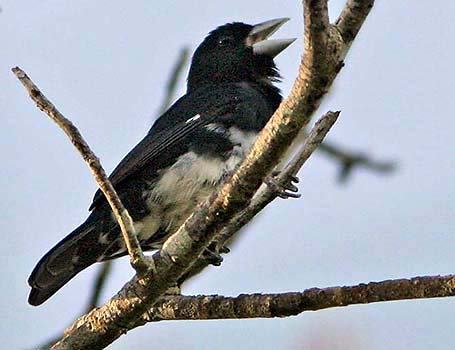 CONE-BILLED TANAGER
CONE-BILLED TANAGER 
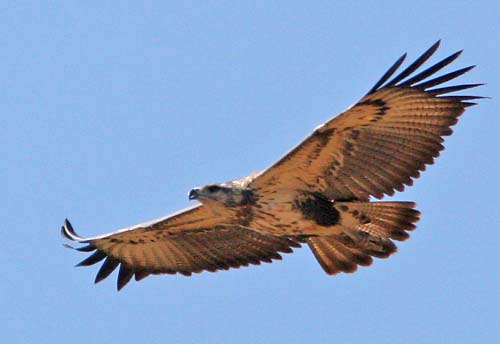 CROWNED EAGLE
CROWNED EAGLE 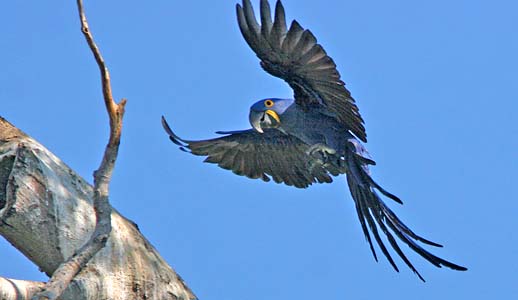 HYACINTH MACAW
HYACINTH MACAW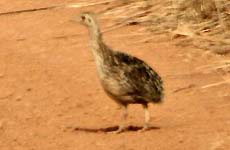 Lesser Nothura
Lesser Nothura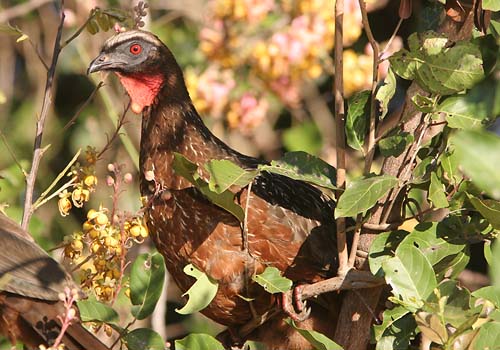 Chestnut-bellied Guan
Chestnut-bellied Guan 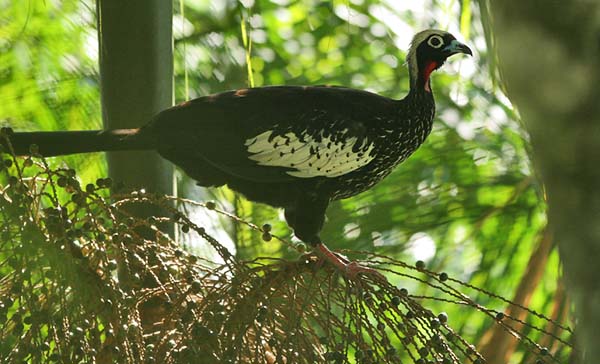 Black-fronted Piping-Guan
Black-fronted Piping-Guan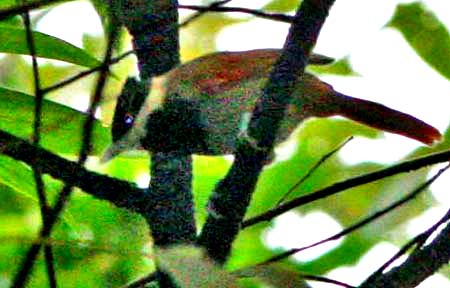 White-bearded Antshrike
White-bearded Antshrike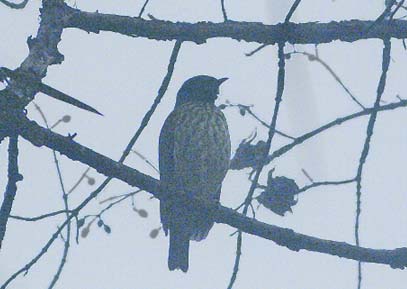 Bare-throated Bellbird
Bare-throated Bellbird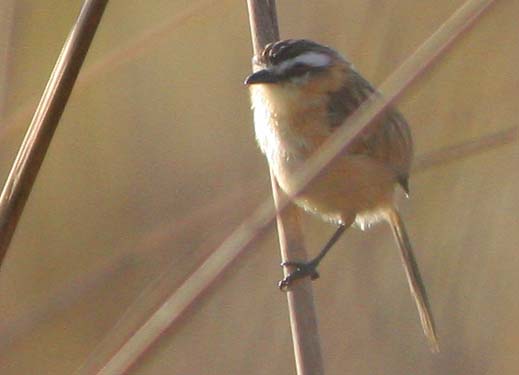 Sharp-tailed Grass-Tyrant
Sharp-tailed Grass-Tyrant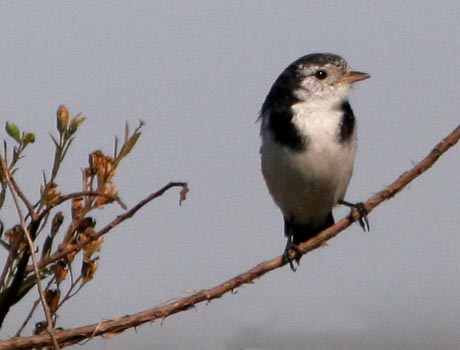 Cock-tailed Tyrant
Cock-tailed Tyrant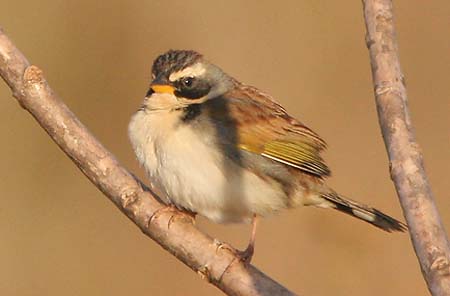 Black-masked Finch
Black-masked Finch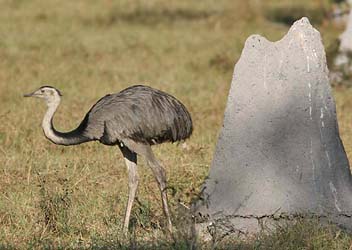 Greater Rhea
Greater Rhea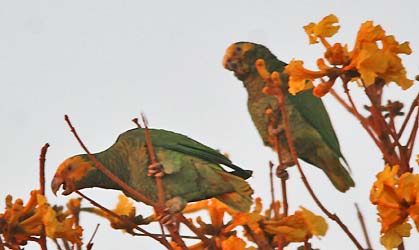 Yellow-faced Parrot
Yellow-faced Parrot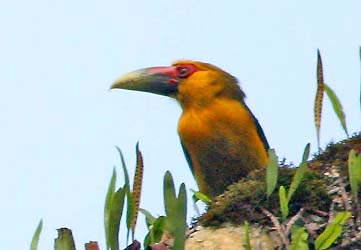 Saffron Toucanet
Saffron Toucanet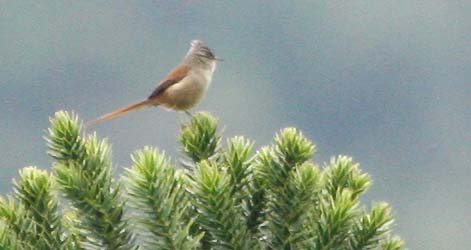 Araucaria Tit-Spinetail
Araucaria Tit-Spinetail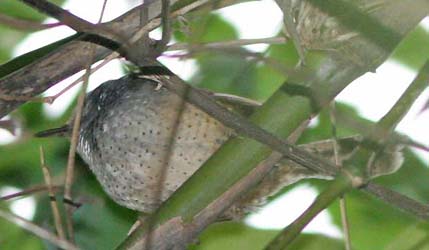 Spotted Bamboowren
Spotted Bamboowren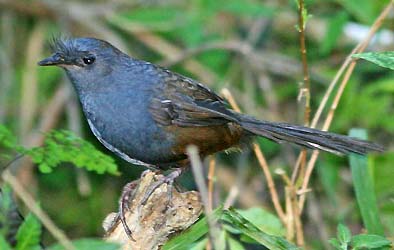 Slaty Bristlefront
Slaty Bristlefront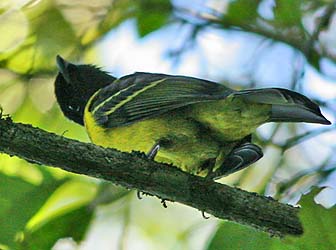 Hooded Berryeater
Hooded Berryeater This
attractive cotinga is a highland specialty in the Atlantic montane
forests. There males sit atop very tall trees and give their
distinctive calls. Edson used those to trick the owner, calling several
in from long distances away, for dramatic views (photo).
This
attractive cotinga is a highland specialty in the Atlantic montane
forests. There males sit atop very tall trees and give their
distinctive calls. Edson used those to trick the owner, calling several
in from long distances away, for dramatic views (photo).  Gray-capped Tyrannulet
Gray-capped Tyrannulet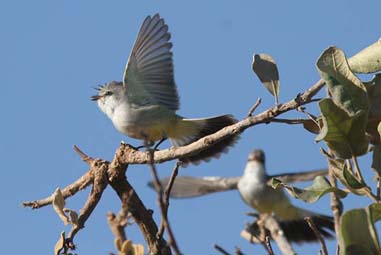 Chapada Flycatcher
Chapada Flycatcher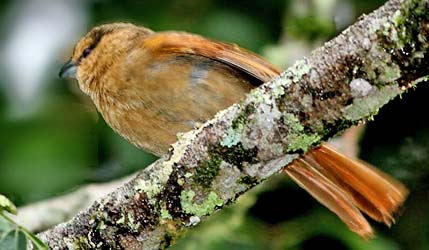 Brown Tanager
Brown Tanager White-banded Tanager
White-banded Tanager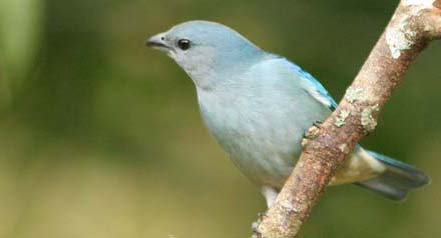 Azure-shouldered Tanager
Azure-shouldered Tanager